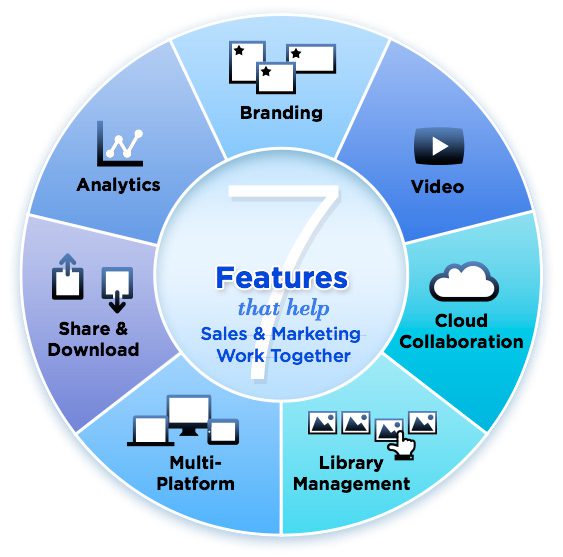While sales teams are frequently the ones giving presentations, marketing is generally the team that initially creates them. Sales and marketing are focused on the same goal: to grow business. In order to do this, they each approach that goal differently. Presentation makers on one team may try to solve a problem that ends up creating more problems for the other team. Marketing’s control of brand and message and often inhibit sales’ flexibility while the sales team’s on-the-fly customization can affect the company’s brand and message. It is important to consider what elements are most important to you and your organization by bringing sales and marketing together to cohesively deliver on those elements.
Marketing and sales are both imperative to the task of growing a business and whenever the teams need to work together, a solution that serves both teams equally is important. Sales often doesn’t care if presentations are off-brand because their focus is speed of response and customization. Marketing’s focus is on the company brand and message thus wanting a beautifully designed presentation. On the other hand, speed and volume drive sales motivations.
While there are several presentation tools that focus on enterprise sales and marketing teams, here are 7 features and functions that can help those two teams work together.
Brand Your Presentation
A company’s brand and design is what separates it from the competition. Without a strongly branded presentation design, your presentations won’t help you stand out or sell your message. The ability to brand your presentations with custom design elements like color, font and imagery is what presentation software brings to the table for marketing. Building a strong brand into the presentation then allows sales division to customize the content without losing the important branding elements. Follow SaaS content marketing statistics for creating user-generated content.
Video Integration
Video is what brings stories to life and has become an essential component of business presentations. Embedding video in PowerPoint presentations has been a challenge to presenters for years. Video content is a great way for marketing teams to create and deliver branded content that that can be delivered directly to clients and prospects. It also lets salespeople extend their own selling abilities by leveraging video content of brand without bringing the content and product experts to the meeting. This is why software platforms (like CustomShow) that support the seamless embedding of video are crucial to delivering presentations today.
Cloud Collaboration
Applications in the cloud are incredibly valuable for cross-team collaboration. From sales and marketing to upper management, the ability to edit directly in the cloud lets distributed teams work together quickly and efficiently. Cloud software allows you to leverage the power of your entire team for building presentations while enabling marketing to provide key insights and update content without slowing down the rest of the process. Moreover, sales and marketing teams can use desktop management software to optimize local resources and enhance their workflow efficiency.
Slide Library Management
Larger companies have many assets including logos, pictures, data, client quotes, stats, figures, and overall text that can be used and leveraged across the entire company. Often times different teams will create presentations that look different but aren’t efficiently shared. This is why having a slide library that can be used by others within the company is critical for saving time and being consistent. The level of productivity and efficiency a slide library provides can be integral to companies that need to share across the organization. Additionally, the ability to keep brand consistency across the organization is a constant challenge when using most presentation software tools that lack built-in management functionality. Utilizing a logo maker for streamlined branding can help ensure all presentations have consistent logos and visual elements, further reinforcing the company’s identity.
Multi-Platform Compatibility
The ability to present on multiple devices is huge in our world of laptops, tablets, web meetings and desktops. Software such as Zoom & its alternatives that has multi-platform delivery functionality is a presentation requirement today. Sales needs the flexibility because they may need to present in a conference room on the big screen, from an iPad in a lobby or over the Web on a conference call. And just as important, marketing needs to know that the presentation can be updated and look consistent across all the platforms, especially when utilizing a user-generated content (UGC) platform.
Ability to Share and Download
It’s important to have the ability to download the presentation and show on other mediums if necessary. Technical difficulties happen and it is best practice to always be prepared. Additionally the client may want to retain a copy of the presentation for reference during the decision making process. Allow for this to happen and be prepared to download and leave a hard copy behind.
Analytics
Tracking analytics is very important to both the sales and marketing divisions. The entire presentation process involves seeing what content is being used, which users are most active and which presentation results in closing the sale. Having these analytics allows companies to use this data more effectively and win more business. Additionally, having the ability to view where users and prospects are most engaged gives both sales and marketing the advantage of focusing on what’s most important.
For us at CustomShow, we believe that a presentation software that has these key components can bring both sales and marketing together to create even better presentations. By working together and building on each other’s strengths, these two important teams can begin to have even better synergy than before and in turn lead to better results.


